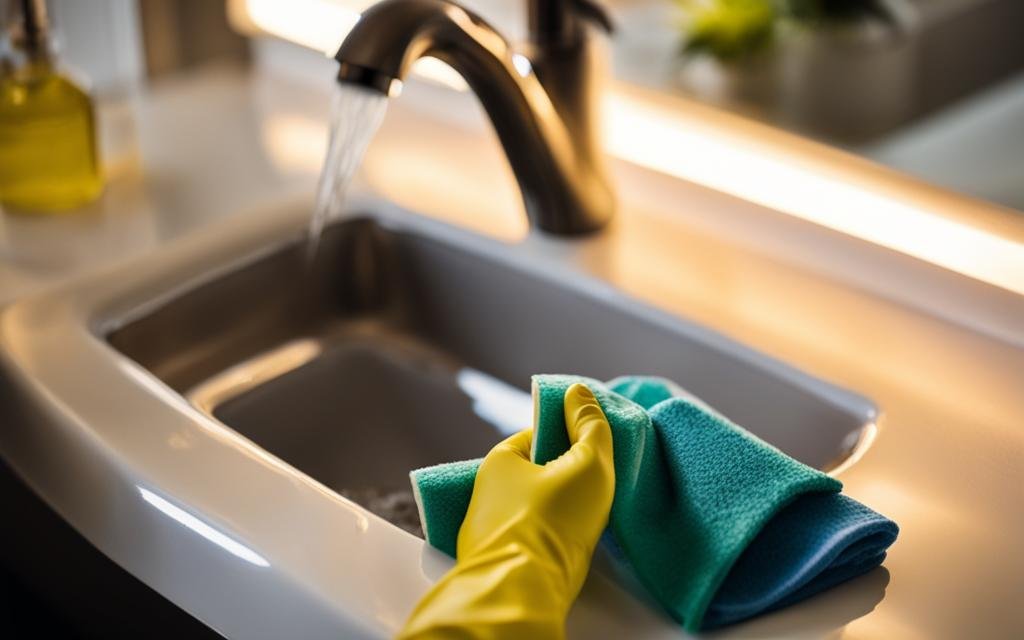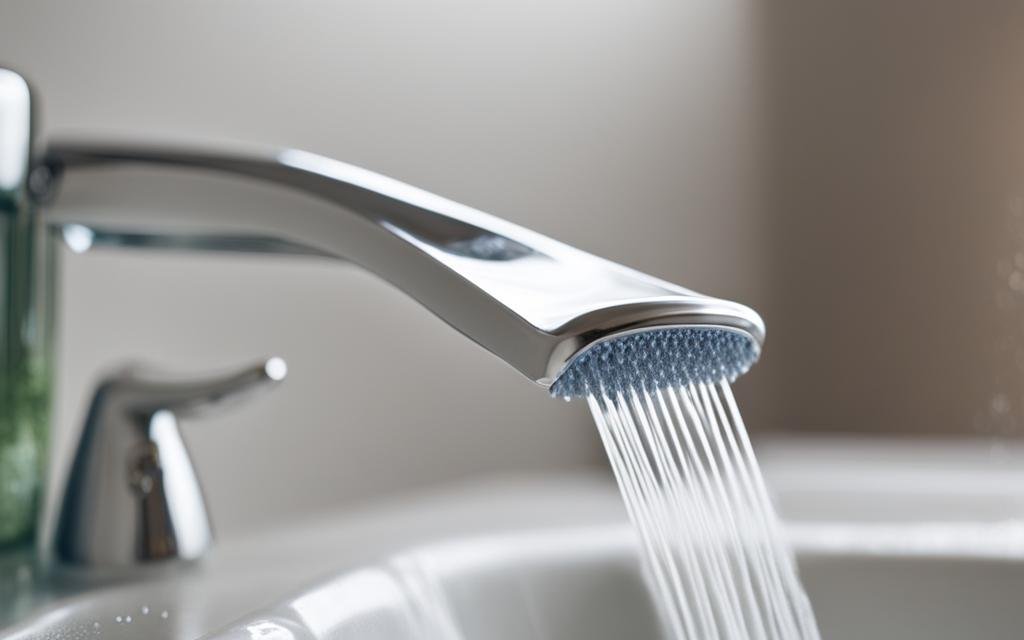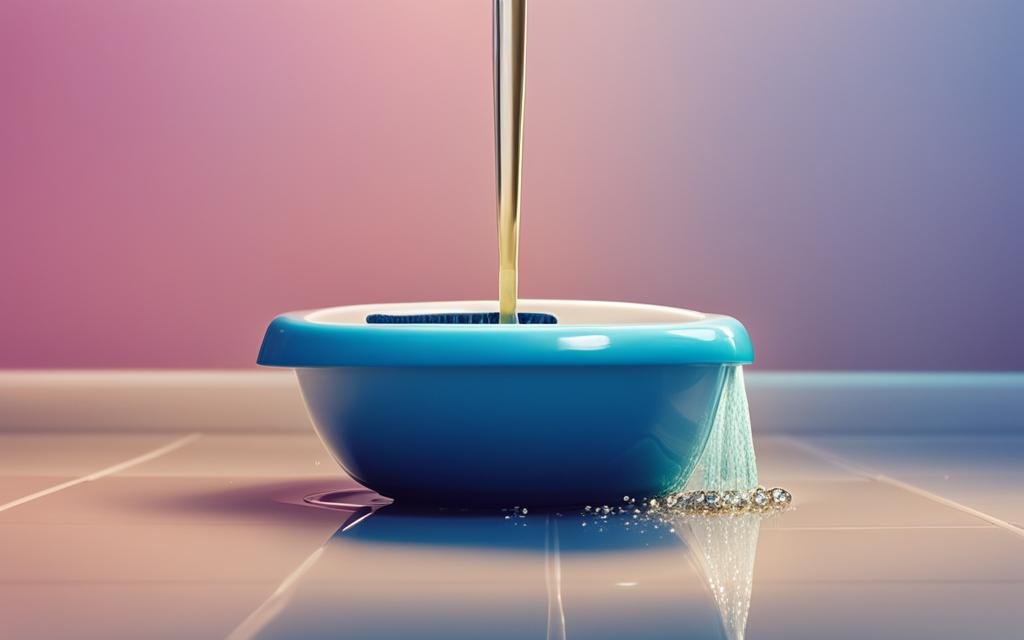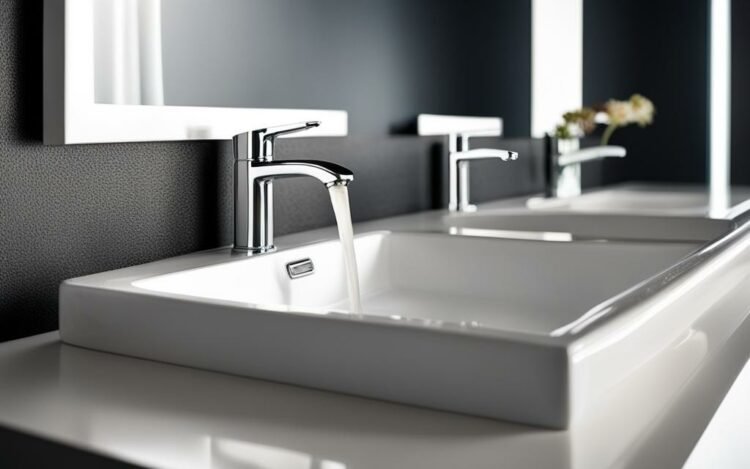Proper maintenance and care are essential for ensuring the longevity of your bathroom faucets. Regular cleaning and attention to detail can help prevent the buildup of bacteria, mold, mineral deposits, and soap scum, keeping your faucets looking their best for years to come. In this guide, we will provide you with essential tips and techniques for maintaining and caring for your bathroom faucets, ensuring they remain functional and pristine.
Key Takeaways:
- Regularly clean your bathroom fixtures to remove bacteria, hard-water deposits, mold or mildew, and soap scum.
- Specific cleaning methods and products may be required based on the material of your bathroom sink, faucet, bathtub, showerhead, and toilet.
- Use general-purpose cleaners, vinegar and water mixtures, or baking soda paste for effective cleaning.
- Avoid abrasive tools and cleansers that could damage the finish of your faucets and fixtures.
- Regular maintenance and cleaning will help extend the lifespan of your bathroom fixtures and keep them looking their best.
How to Clean and Maintain a Bathroom Sink
To keep your bathroom sink clean and prevent soap scum buildup, it’s important to follow a regular cleaning routine. By using the right cleaning solutions and techniques, you can maintain the cleanliness and shine of your bathroom sink for years to come.
1. Gather the necessary cleaning supplies:
- A general-purpose spray cleaner or a mixture of vinegar and water
- A mildly abrasive cleanser or a paste made from baking soda and water
- A soft cloth or sponge

2. Apply the cleaning solution:
Start by spraying the general-purpose cleaner or vinegar and water mixture onto the surfaces of the sink. For stubborn grime, apply the mildly abrasive cleanser or baking soda paste directly to the affected areas. Use a soft cloth or sponge to spread the cleaning solution evenly.
3. Scrub and rinse:
Gently scrub the sink surfaces, focusing on areas with stains or buildup. Pay special attention to the faucet fixtures and drain. Rinse the sink thoroughly with warm water to remove any residue from the cleaning solution.
4. Dry and shine:
Use a clean, dry cloth to dry the sink and prevent water spots. Buff the surfaces to bring out the shine and leave your bathroom sink looking fresh and clean.
By following these cleaning steps regularly, you can ensure that your bathroom sink stays free from soap scum and maintains its pristine appearance. Remember to always use appropriate cleaning solutions and tools for the material of your sink to avoid any damage.
Tips for Cleaning and Maintaining Bathroom Faucets
To keep your bathroom faucets looking their best and functioning properly, regular cleaning and maintenance are essential. By following these tips, you can ensure the longevity of your bathroom faucets:
- Clean with care: Use a mild dish soap and water solution to clean the surface of your bathroom faucets. Avoid using abrasive tools or harsh chemicals that could damage the finish. For tougher grime, a mixture of vinegar and water can be used, but always test it in an inconspicuous area first to ensure compatibility with the faucet’s finish.
- Gentle scrubbing for stubborn stains: For stubborn stains or buildup, use a soft toothbrush and a paste made from baking soda and water. Gently scrub the affected areas to remove the stains without scratching the surface of the faucet.
- Dry thoroughly: After cleaning, make sure to dry the faucet thoroughly with a clean, dry cloth to prevent water spots and maintain its shine.
- Maintain the finish: To preserve the finish of your bathroom faucet, avoid using abrasive sponges or stiff-bristled brushes. These can scratch the surface and diminish its appearance over time. Stick to gentle cleaning methods and products recommended by the manufacturer.
- Regular inspections: Periodically check your bathroom faucets for any leaks, loose handles, or other issues. This allows you to address any problems promptly and prevent further damage.
By incorporating these cleaning and maintenance tips into your routine, you can keep your bathroom faucets looking beautiful and ensure their long-lasting performance.
Cleaning and Maintaining Bathtubs and Showerheads
Proper cleaning and maintenance of your bathtubs and showerheads are essential for ensuring their longevity and optimal performance. Neglecting these fixtures can lead to the buildup of limescale, mold, and other unsightly residues. By following the right cleaning techniques and regularly descaling your showerheads, you can keep these bathroom essentials in top shape. Here are some tips to help you clean and maintain your bathtubs and showerheads:
1. Bathtub Cleaning:
- For porcelain or ceramic bathtubs, use a general-purpose cleaner, vinegar and water solution, or a baking soda paste to remove dirt and stains.
- Avoid using undiluted bleach on porcelain tubs, as it can damage the finish. Instead, opt for stain-removing cleansers for rust stains.
- Acrylic and fiberglass tubs can be cleaned with a small amount of dish soap and water. Wipe the surface with a soft cloth to prevent scratches.
2. Showerhead Maintenance:
- To prevent limescale buildup, fill a plastic bag with white vinegar and attach it to the showerhead using a rubber band. Leave it for an hour, then remove the bag and polish the showerhead with a soft cloth.
- If your showerhead has a specialty finish like oil-rubbed bronze or brass, refer to the manufacturer’s care instructions to avoid damaging the surface.
- Regularly check the showerhead for any mineral deposits or debris that may be affecting water flow. Use a toothbrush to gently scrub away any buildup.
By incorporating these cleaning and maintenance practices into your bathroom routine, you can ensure that your bathtubs and showerheads remain clean, functional, and free from limescale buildup. Remember to follow the manufacturer’s guidelines for specific cleaning instructions based on the materials and finishes of your fixtures.

Cleaning and Sanitizing Toilets
To maintain a clean and hygienic bathroom, it is important to regularly clean and sanitize your toilet. By following these simple steps, you can keep your toilet sparkling clean and prevent the spread of germs.
1. Cleaning the Exterior
Start by spraying a general-purpose cleaner or a mixture of vinegar and water on the exterior surface of the toilet. Wipe it clean using a soft cloth or sponge. Pay attention to areas that may have splashes or drips, such as the toilet seat and the surrounding area. For stubborn stains, use a mild cleaner, like dish soap, mixed with water to gently scrub the surface. Wipe off any residue with a dry cloth to leave the exterior looking pristine.
2. Sanitizing the Toilet Bowl
To sanitize the toilet bowl, it is important to use an antibacterial toilet cleaner or a solution of 1/4 cup bleach to 1 gallon of water. Apply the cleaner to the inside of the bowl and scrub it thoroughly with a toilet brush. Pay special attention to the rim, the waterline, and under the rim where bacteria can accumulate. After scrubbing, flush the toilet to rinse away the cleaning solution. Wipe off any remaining residue with a soft, dry cloth.
3. Regular Maintenance
In addition to regular cleaning, it is important to perform regular maintenance tasks to keep your toilet in optimal condition. Check and replace small components like springs and seats as needed. This will prevent any potential issues and ensure that your toilet continues to function properly. Understanding the warranties associated with your toilet can also be helpful in case of any unforeseen problems.
By following these cleaning and maintenance tips, you can keep your toilet clean, fresh-smelling, and hygienic. Remember to always use the appropriate cleaning products and tools for your toilet to prevent any damage or discoloration. With regular care, your toilet will remain in great condition, providing you with a clean and comfortable bathroom experience.
Image:

Conclusion
Proper maintenance and care are essential for ensuring the longevity of your bathroom faucets and fixtures. Regular cleaning, using the appropriate methods and products for each material, will help prevent the buildup of bacteria, mold, mineral deposits, and soap scum. It’s important to follow the manufacturer’s instructions for cleaning and care, especially for specialty finishes.
In addition to cleaning, regular maintenance tasks such as checking and replacing small components like springs and seats can help keep your faucets in good working order. Understanding the warranties associated with your faucets can also save you money in case of any issues.
By implementing these long-lasting bathroom faucet care and maintenance tips, you can extend the lifespan of your bathroom faucets and enjoy a clean and functional bathroom for years to come.

